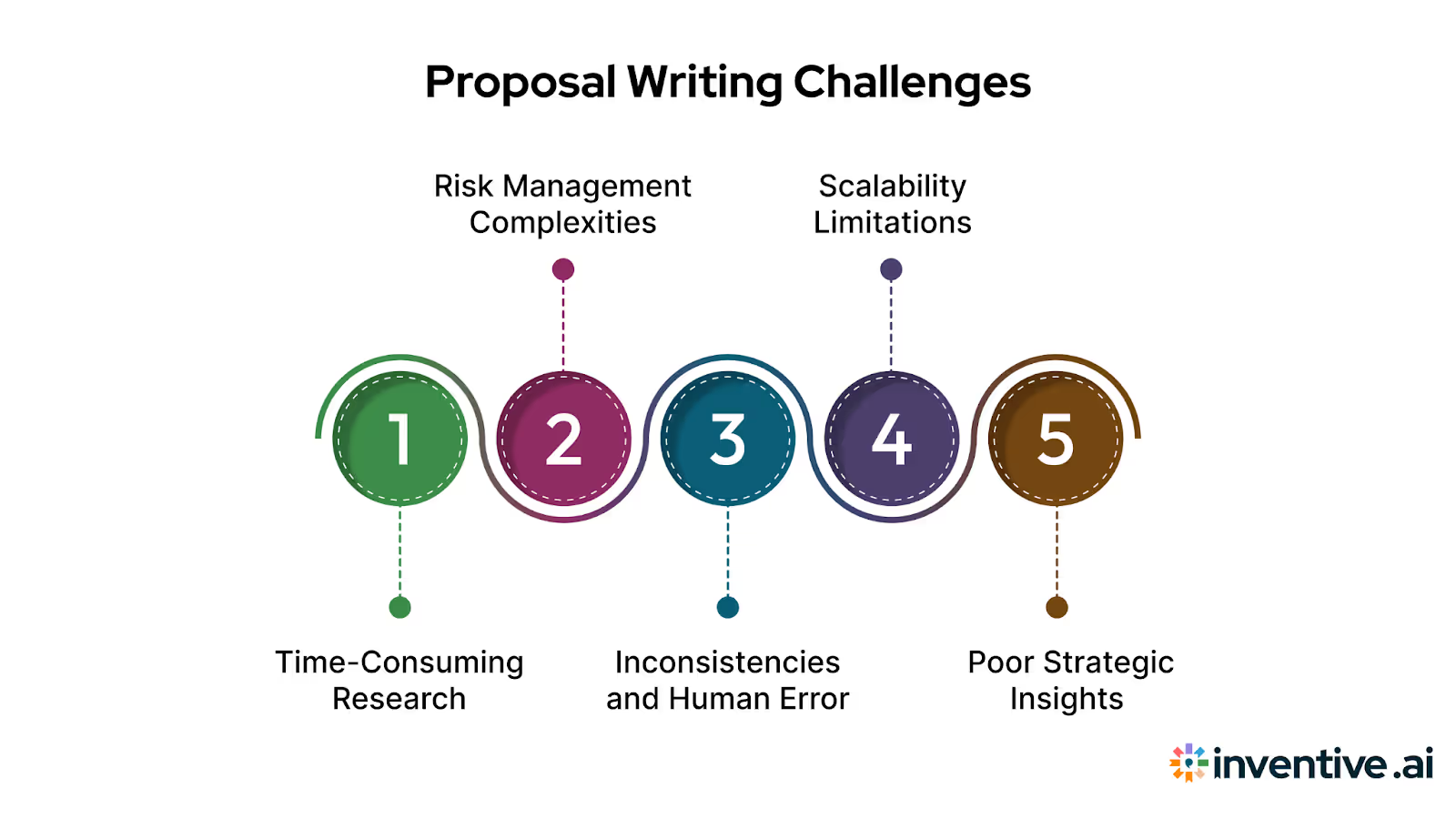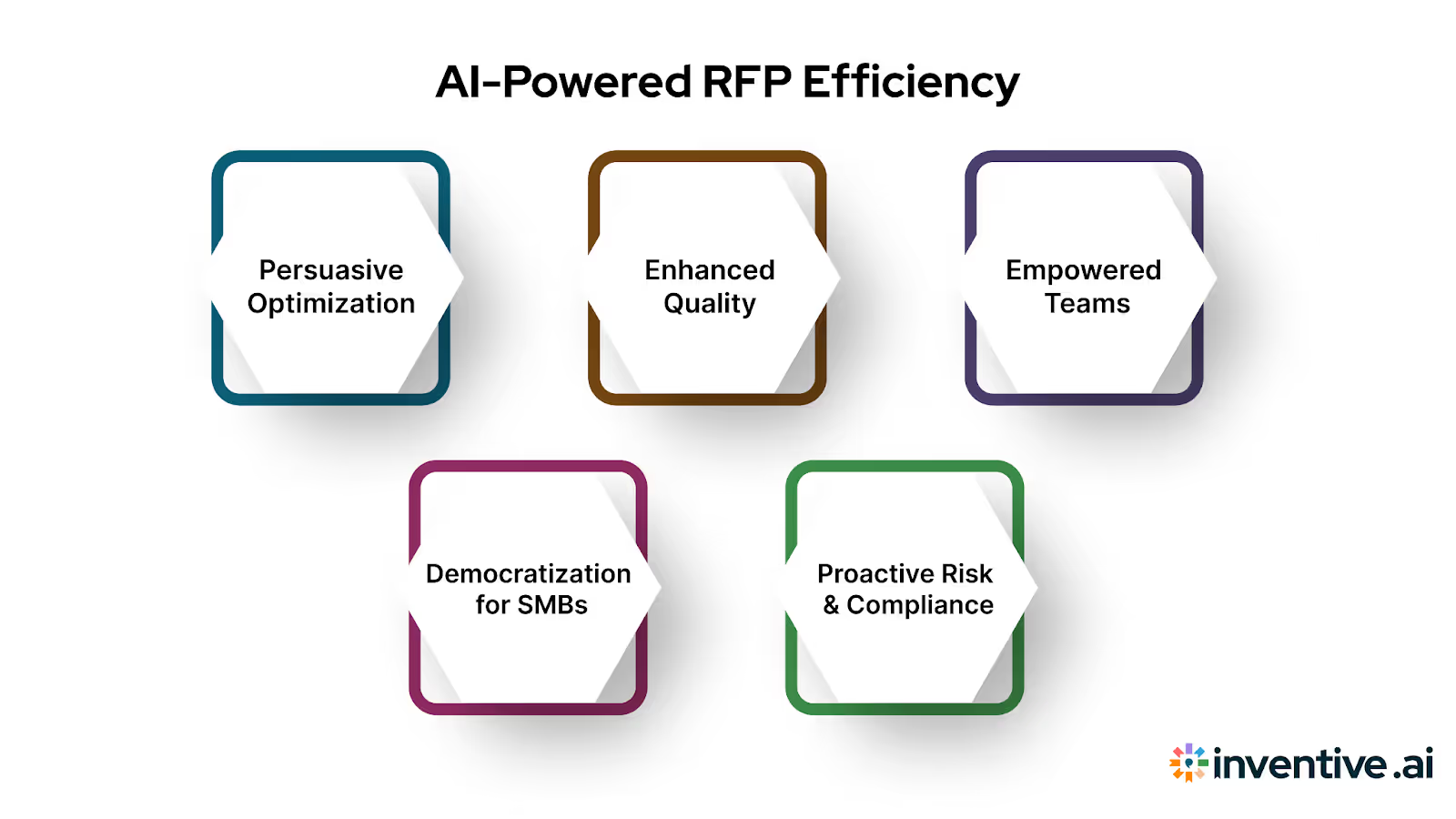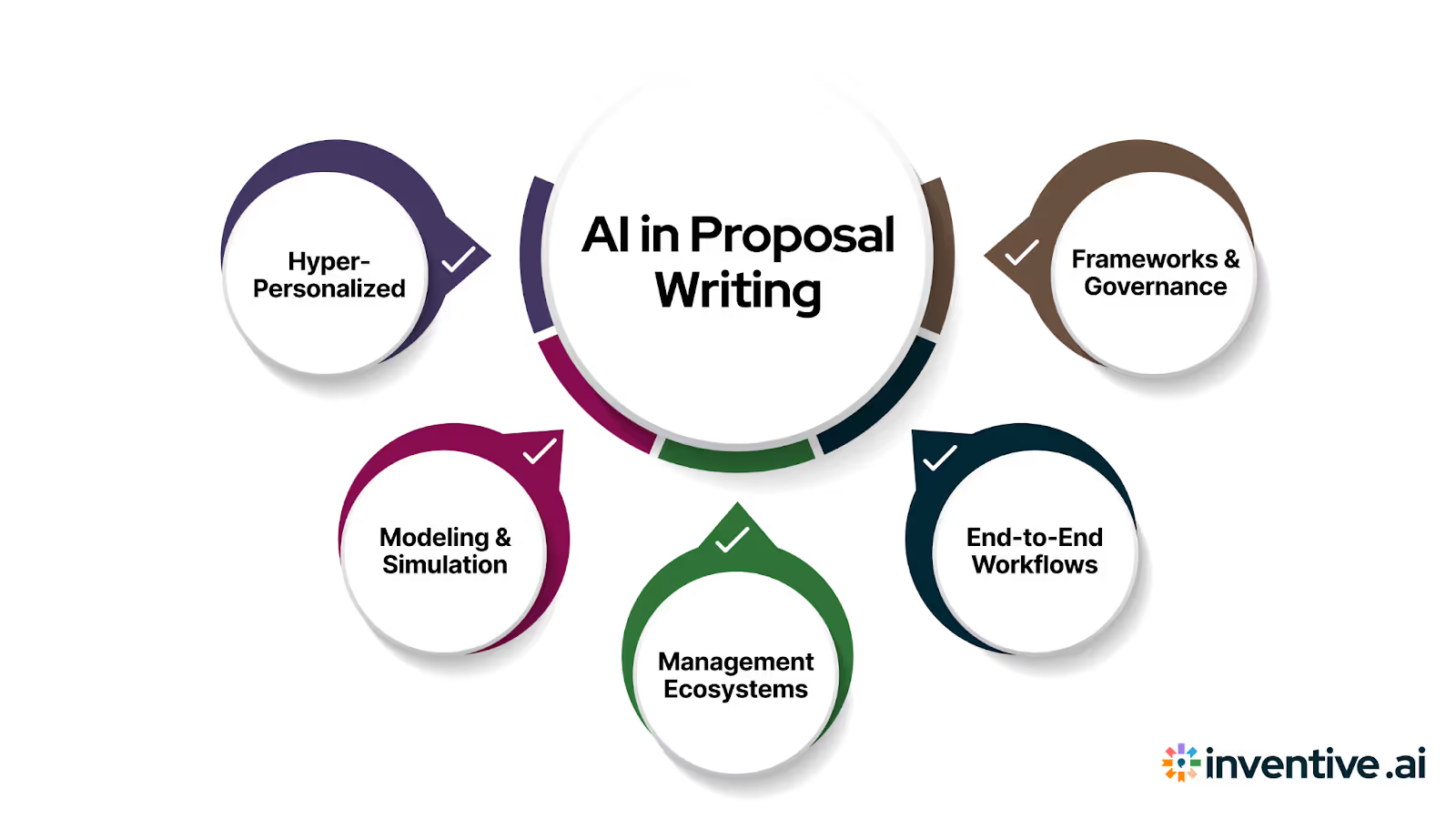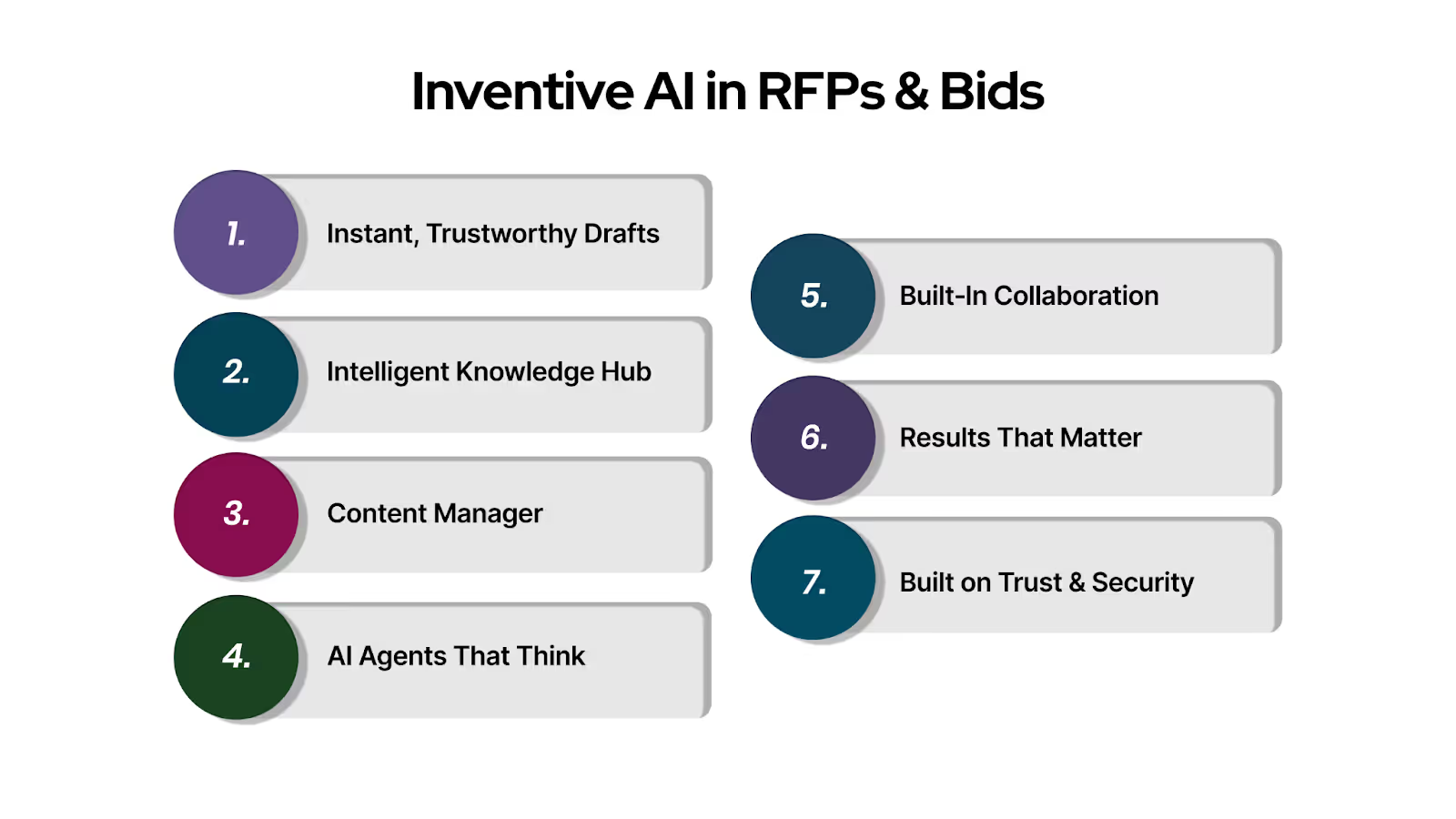How AI Transforms Proposal and Bid Writing
Discover how AI is transforming proposal and bid writing, cutting drafting time, improving win rates, reducing risk, and enhancing team productivity.

Writing proposals and bids has always demanded time, precision, and coordination. But for most teams, the process is still tangled in scattered files, outdated content, and long email threads. Drafts take days. Reviews stretch deadlines. Valuable hours are lost chasing information that should be easy to find.
With AI and the right systems in place, teams can pull accurate content from a central source, generate strong first drafts in minutes, and focus on strategy instead of grunt work.
In this article, we’ll break down how AI is reshaping every part of the proposal and bid process, from research and drafting to review and submission, while highlighting the tools and technologies making it possible.
Key Takeaways
- Traditional proposal writing is time-consuming and error-prone, with scattered content, manual compliance checks, and inconsistent messaging.
- AI streamlines the entire proposal lifecycle, from opportunity qualification to submission, by automating research, drafting, formatting, and compliance reviews.
- Technologies like NLP, generative AI, ML, and agentic AI power faster, smarter, and more accurate responses with less manual effort.
- AI enhances quality, consistency, and win rates by learning from past submissions, optimizing language, and applying proven success patterns.
- Collaboration improves with AI, which helps manage version control, assigns tasks, and ensures brand and tone consistency across teams.
- Even small teams can now compete with large firms, thanks to scalable AI tools that eliminate the need for added headcount.
- AI ensures proactive compliance and reduces legal risk, with real-time checks and automated packaging that align with RFP requirements.
- Human-AI synergy is key: AI handles repetitive tasks, while human experts focus on strategy, persuasion, and relationship-building.
- The future of proposal writing is predictive and personalized, with AI tailoring responses to each buyer’s pain points and scoring proposals before submission.
- Platforms like Inventive AI lead the charge, delivering intelligent drafting, knowledge management, and measurable performance improvements.
The Pain Points of Traditional Proposal & Bid Writing

Time-Consuming Research & Content Creation
- Teams often waste hours hunting for information across emails, spreadsheets, and legacy tools.
- Subject matter experts are repeatedly pulled into the same questions for different bids.
- No single source of truth results in redundant work and slow response times.
Compliance & Risk Management Complexities
- Manual tracking of legal and RFP requirements leads to overlooked clauses.
- No automated safeguards to flag compliance gaps early in the drafting process.
- Risk of exposing the company to contractual issues due to inconsistent wording.
Inconsistencies and Human Error
- Teams use varying formats, tones, and messaging across different proposals.
- Version control problems cause duplication, contradictions, and misalignment.
- Errors in final submissions reduce credibility and impact win rates.
Scalability Limitations for SMBs/Large Teams
- Small teams can't keep up with growing RFP volumes without burning out.
- Large teams face delays and confusion due to siloed workflows and lack of coordination.
- Scaling bid efforts requires smarter systems, not just more people.
Data Overload and Poor Strategic Insights
- Past proposal data and outcomes are rarely analyzed or reused.
- No clear understanding of what works and what doesn’t across submissions.
- Teams rely on instinct instead of insight, limiting long-term improvement.
To understand how this shift is possible, let’s look at the core AI technologies driving the change in proposal and bid writing.
AI Across the Proposal & Bid Lifecycle: A Stage-by-Stage Revolution
Core AI Technologies Powering the Revolution
Behind the shift in proposal writing is a combination of AI systems working together to take the pressure off teams, surface better decisions, and speed up workflows. Here’s a closer look at the tech that’s reshaping how bids are planned, written, and delivered.
Natural Language Processing (NLP) for Content Analysis & Generation
NLP is what allows AI to “read” and understand dense RFPs, dissect them into structured requirements, and map them against your internal knowledge. It can instantly pull the right answers from past submissions or knowledge bases and rewrite them in a way that fits new prompts. NLP also supports deeper content indexing, helping teams surface buried insights that would otherwise be missed in large document libraries.
Generative AI for Drafting & Ideation
Proposal teams can rely on it for strong first drafts that match tone, respond directly to buyer needs, and reflect the language of prior wins. It also serves as a sounding board for new ideas, producing alternative phrasings, executive summaries, or even full narratives when teams hit a creative wall. Instead of starting from scratch or recycling flat language, teams start with intelligent drafts they can shape and fine-tune.
Without generative AI, content-heavy tasks like drafting FAQs or product documentation average 116 minutes (McKinsey). Proposal sections often demand even more time, AI tools bring that down dramatically, often producing first drafts in minutes.
Platforms like Inventive AI tap into this approach, using our own suite of AI agents to manage content sourcing, competitor research, and even flag outdated responses, all without constant prompting from the team.
Machine Learning (ML) for Data-Driven Insights & Optimization
ML shines when it comes to learning from past outcomes. It can analyze which bids were won or lost, which content resonated with evaluators, and which patterns are emerging across your pipeline. That feedback loop gets smarter over time. ML can suggest response strategies, flag risky phrasing, or recommend higher-performing content blocks.
Agentic AI for Automated Task Execution
Agentic AI is where things shift from suggestion to action. Unlike traditional AI, which waits for instructions, agentic systems carry out tasks independently. Proposal agents can be assigned a goal, drafting answers to recurring questions, and they’ll complete the job while you focus on higher-level work. These agents bring structured delegation into the mix, which is critical for teams juggling dozens of active proposals and tight turnarounds.
Data Analytics for Bid Strategy & Win Probability
Proposal writing is only half the battle. Knowing which RFPs to pursue, and how to structure your approach, can change the outcome before a single draft is written. AI-powered analytics can assess an opportunity’s fit and score win probability.
How to Get Started with AI Bid Writing: A 5-Step Guide
Here's a practical framework to guide your AI adoption journey.
Step 1: Centralize Your Knowledge Base
Before AI can start working, it needs access to quality, organized content. Most teams have valuable proposal assets scattered across email attachments, individual hard drives, and forgotten shared folders.
Start by gathering your strongest performing content: winning proposals, approved boilerplate text, technical specifications, case studies, and FAQ responses. Create a structured repository tagged by topic, solution area, and client type. Include metadata like win/loss outcomes to help AI understand what works.
Establish content governance rules from the start. Designate owners for different content areas, set review cycles, and create approval workflows. Consider organizing content by RFP section types (technical approach, company background, pricing methodology) rather than by individual proposals.
Step 2: Choose the Right AI Platform
Evaluate platforms based on your team's specific needs: RFP volume, compliance requirements, existing tech stack integrations, and team size. Look for platforms with transparent AI decision-making and industry-appropriate security standards. Test platforms with real RFPs from your pipeline, not just demo scenarios.
Step 3: Train Your AI with Winning Content
AI learns from examples, so training content quality directly impacts output quality. Feed your system with the best-performing proposals plus context about why they won. Create training datasets that include both successful responses and original RFP requirements.
Start with your strongest content in key solution areas, test AI outputs, and iteratively add more content based on performance. Establish feedback loops where proposal team members can rate AI-generated content and provide corrections for continuous improvement.
Step 4: Integrate AI into Your Existing Workflow
Map out your existing proposal workflow and identify tasks where AI adds the most value. Start with pilot projects on lower-stakes RFPs focusing on time-consuming tasks like generating compliance matrices, drafting standard sections, or formatting responses. Ensure your team understands their evolving roles and build quality checkpoints into your AI-enhanced workflow.
Step 5: Measure, Refine, and Scale
Track both efficiency and effectiveness metrics from day one: time saved, proposals completed, win rates, and client satisfaction scores. Create regular review cycles to assess AI performance and identify improvement opportunities.
As confidence grows, gradually expand AI usage to more complex proposals and additional team members. Scale thoughtfully with appropriate training content and quality controls. Document lessons learned for onboarding new team members.
How AI Enhances RFP Response Efficiency

Let’s look at how AI speeds up the RFP process, reduces manual effort, and helps teams respond smarter and faster.
Elevated Win Rates: Data-Driven Strategies & Persuasive Optimization
AI tools now track the characteristics of winning bids, tone, structure, pricing language, themes, and apply those learnings to new proposals. Instead of chasing every opportunity, teams can prioritize RFPs that align with proven success patterns. With smarter scoring models and real-time persuasion tuning, responses are stronger and more targeted.
Enhanced Quality & Consistency: Reduced Errors, Unified Brand Voice
When content is pulled from structured knowledge sources and reviewed by AI for inconsistencies, it naturally begins to sound like one voice. No more switching between writing styles or risking outdated information. AI maintains formatting standards, language style, and compliance tone automatically, reducing back-and-forth edits and ensuring every proposal feels coherent from start to finish.
Empowered Teams: Focus Shift from Admin to Strategy & Relationships
Admin work such as chasing approvals, locating source documents, and formatting tables, is a silent time sink. With AI handling repetitive tasks, proposal managers and SMEs can focus on tailoring win themes, building client trust, and developing strategy. The shift is about giving skilled people the space to do better work.
McKinsey estimates that generative AI accelerates content-heavy drafting tasks by up to 40%, reducing time spent on repetitive work and allowing proposal professionals to invest more in strategy and client insight.
Democratization for SMBs: Leveling the Playing Field Against Larger Competitors
Traditionally, larger firms dominated proposals with sheer headcount, more writers, more reviewers, more volume. AI changes that. Small teams using smart tools can now match or outperform those with bigger budgets. With systems like Inventive AI, even lean teams can manage multiple RFPs in parallel, maintain quality, and bring in competitive intelligence without hiring extra hands.
Proactive Risk & Compliance: Real-Time Safeguards
Mistakes in a proposal can open companies up to legal and financial exposure. AI tools now scan for risk language, missing clauses, and non-compliant phrasing before the document ever reaches a reviewer. These early alerts prevent last-minute rewrites and allow teams to flag problems upstream, where they can be addressed with less pressure.
Human-AI Synergy
AI is here to handle the repetitive, time-consuming tasks so teams can focus where their expertise matters most.
But strategy is still a human strength. Crafting a winning proposal means framing the response to the client's pain points, translating features into benefits, and striking the right tone, all guided by insights from sales conversations, cultural context, and stakeholder dynamics. These are things only humans can truly interpret.
That’s why human review remains essential. Even accurate AI outputs need refining to ensure clarity, nuance, and alignment with the client’s expectations. Final sign-off, especially on high-stakes bids, must stay in human hands.
For AI to keep improving, it needs training, through curated, up-to-date content and regular feedback. Platforms like Inventive AI allow teams to align AI outputs with their unique voice and strategy.
It’s a collaboration. With clear roles, AI and humans together create faster, sharper, and more competitive proposals.
AI in Proposal & Bid Writing

The next phase of AI in proposal writing will make the entire process more intelligent, interconnected, and deeply tailored.
Hyper-Personalized Proposal Generation
AI is moving beyond template matching. With deeper access to CRM data, buyer behavior, and past interactions, proposals will start reflecting the unique pain points, language, and goals of each prospect. Proposals will mirror a client’s tone, anticipate objections, and speak directly to the evaluator’s mindset, drafted in minutes, not days.
Predictive Scenario Modeling & Simulation
Soon, AI will simulate how a proposal might score before it's even submitted. By modeling against historical win/loss data, industry benchmarks, and known buyer preferences, teams will be able to test different approaches, pricing strategies, messaging angles, even formatting choices, and choose the version with the highest predicted impact.
Seamless Integration with CRM, ERP & Project Management Ecosystems
AI won’t stay siloed. It’s already starting to pull from Salesforce, SharePoint, gDrive, and other internal systems, but deeper integrations are next. Proposal tools will sync with sales forecasts, project delivery timelines, compliance logs, and finance systems. This means real-time data feeds into proposals, fewer handoffs, and submissions that align with what the business can actually deliver.
Advanced Agentic AI Handling End-to-End Workflows
Current AI agents handle discrete tasks like drafting, sourcing, and formatting, but future agents will manage entire workflows. A single agent could intake an RFP, extract requirements, check feasibility, draft the response, assign reviewers, package final documents, and trigger submission.
Evolving Ethical Frameworks & Governance
As AI writes more content and touches sensitive client data, ethical use becomes non-negotiable. The next wave will bring stricter governance tools, audit trails for AI decisions, control over source data usage, and role-based access to generated content.
The tools are getting sharper, but the change ahead is deeper than tech. Proposal writing is becoming more strategic, more predictive, and more client-aware than it’s ever been. The firms that adapt to this shift early will win more business.
AI Tools Comparison for Proposal and Bid Writing
The table below compares leading AI tools for proposal and bid writing across key features, helping you see how each platform stands out in terms of capabilities and workflow support.
How Inventive AI Champions the Revolution in RFPs & Bids

Inventive AI is built to power every stage of the RFP journey, from parsing to final export, and delivers on the promise of AI-enhanced proposal writing with real-world results:
Instant, Trustworthy Drafts
Inventive’s proprietary AI system pulls from all of your approved content and delivers first-draft responses in seconds. Reviews show it's up to 10× faster than manual drafting and rooted in accuracy.
A Single Intelligent Knowledge Hub
No more hunting through folders. Inventive integrates with Google Drive, SharePoint, Notion, Slack, Salesforce, and more, consolidating all your Q&A, technical specs, past proposals, and collateral into one searchable, up-to-date source.
Content Manager That Keeps It Fresh
Stale or conflicting content is flagged automatically. Inventive’s Content Manager ensures every response draws from the latest, most accurate version, cutting errors and outdated information.
AI Agents That Think for You
Beyond drafting, the platform offers AI agents designed to clarify requirements, scout competitors, brainstorm win themes, or polish responses. These agents handle heavy lifting so your team focuses on strategy.
Built‑In Collaboration & Control
Inventive supports assigning sections, live editing, comment tracking, and role-based access. Audit trails and version control mean you can see who changed what, when, and roll back easily if needed.
Results That Matter
Users report up to 90% faster turnaround, 50% higher win rates, and 2.5× more submissions in just a few months, making AI more than a time-saver; it becomes a competitive strategy.
Built on Trust & Security
With SOC 2 compliance, enterprise-grade encryption, and integrations that respect internal governance, Inventive ensures your sensitive proposal data stays secure.
“Future of RFP/RFI/security questionnaire responses! Saves our team a ton of time.
Lot of great features. User experience is extremely intuitive, and the team is very responsive.”
— Head of Solutions, Outreach
This testimonial shows how Inventive AI helps teams save time, work more smoothly, and get better results. The user-friendly design and helpful support make it easy to use, even for complex RFPs. It’s a tool that makes real work faster and simpler.
If you’re ready to transform how your team approaches RFPs, automating drafting, reducing risk, and increasing wins, book a demo with Inventive AI today.
Frequently Asked Questions (FAQ)
1. What is “AI-powered proposal writing” and how does it differ from traditional methods?
AI-powered proposal tools combine natural language processing (NLP), machine learning (ML), knowledge base indexing, and generative AI to interpret RFP requirements, surface the right content, and draft responses, often in minutes. Unlike manual writing from scratch, AI tools repurpose vetted content intelligently and adapt tone and structure to match RFP language. It’s about augmenting human workflows, not replacing them
2. How much time can AI save in RFP response cycles?
AI-driven automation can slash drafting time by 50–70% or more. Many teams report completing first draft within minutes, leaving only polishing and customization for human editors, not endless back-and-forths with SMEs.
3. Can AI help ensure compliance with RFP requirements?
Yes. AI tools can automatically generate a dynamic compliance matrix, flag missing answers or legal clauses in real-time, and ensure consistent adherence to internal and external standards. This minimizes manual oversight lapses and legal risk.
4. What are best practices when adopting AI in proposal workflows?
- Start with a well‑curated central knowledge base.
- Train AI systems with approved, branded language and feedback loops.
- Keep humans in quality‑control and escalation workflows.
- Integrate AI tools with existing CRMs, content repositories, and document systems.
- Pilot first, monitor metrics (turnaround time, win rate uplift), and refine before scaling.
5. What reporting or analytics should teams monitor once AI is in use?
- Draft time saved and submission throughput.
- Win rate changes or trends in evaluator feedback.
- Compliance gap violations, risk alerts flagged by AI.
- Content usage patterns (which winning snippets are reused the most).
- These metrics enable teams to optimize content performance and strategy alignment continuously.


